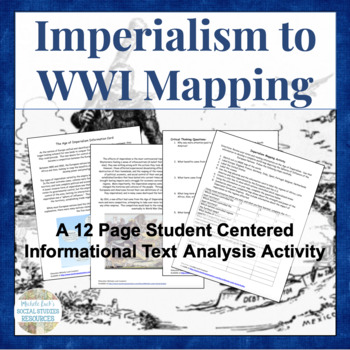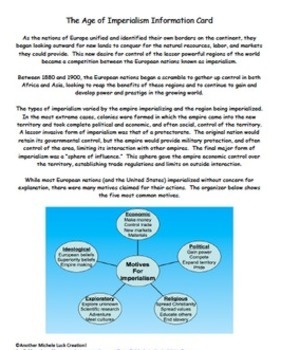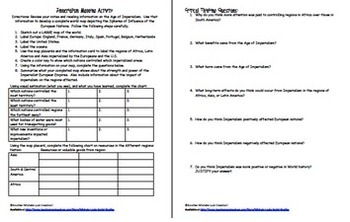Imperialism to WWI Mapping Activity Informational Reading Events Leading to War
- PDF
- Easel Activity
What educators are saying
Description
Teaching how Imperialism led to WW1? Want an engaging lesson on Imperialism that will allow students to practice mapping skills? This resource will be the one that sets a great foundation for your Imperialism to WWI Unit!
Imperialism to WWI Mapping Activity is a great resource for introducing the WWI era as students map the imperialism that spread from Europe and beyond to create the conflicts and chaos leading to the great war.
This mapping and information gathering activity will help students understand the changes in geography during the Age of Imperialism just before WWI.
Activity requires students to complete maps on the Age of Imperialism and provides an assortment of critical thinking questions at the end for a thorough wrap-up.
Includes:
Student Mapping Activity Guide
Blank Map
Information Cards
Maps & Other Media
Guiding Questions
Wrap-Up/Critical Thinking Questions
Skills Practiced:
Map Reading & Mapping
Primary Source Analysis
Image Analysis
Historical Thinking
Historical Inquiry
Cause & Effect
Comparison
Great as study guide for Imperialism unit.
All resource placards and informational readings are provided for this activity, but this will go well with my PowerPoint on the Impact of Imperialism.
Take a look at my many other Imperialism Resources:
• Imperialism to WWI Mapping Activity
• Imperialism to WWI Primary Source Analysis Bundle
• Avatar Viewing Guide with Imperialism Correlations
• US Coming of Age Imperialism Lecture Notes
• Imperialism of Africa 4-Thought Organizer Reading Guide & Lesson Materials
• Imperialism of Asia 4-Thought Organizer Reading Guide & Lesson Materials
• Imperialism of Asia and Latin America Lecture Notes
• Complete Introduction to Imperialism & Imperialist Motives Lecture Notes
• Age of Imperialism Guided Student Notes Set
• Imperialism Brief Overview Introduction Lecture Notes
• U.S. History American Imperialism Lecture Notes
• Impact of Imperialism Leading to WWI Lecture Notes w/Primary Sources
• American Imperialism Reading & SPRITE Graphic Organizer
Find my Complete Unit on Nationalism, Unification & Imperialism for World History here!
See other Mapping Activities in my Geography IN History Series!
Buying from Michele Luck’s Social Studies
If you like this resource, please leave feedback. If you have any questions or concerns, please email me at michele@micheleluckssocialstudies.com to let me know!
You may also want to browse through my TpT Store for other rigorous and collaborative Social Studies resources that can make your in-class or digital and distance learning classroom more interactive for all students!
Thank you for downloading. Happy Teaching!






